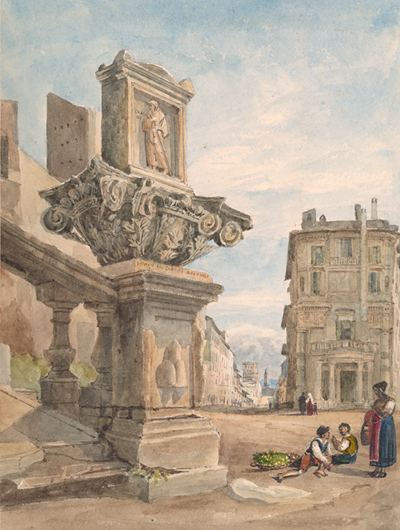
Rome exists not only as an intensely physical place, but also as a romantic idea onto which artists, poets, and writers project their own imaginations and longings. City of the Soul examines the evolving image of Rome in art and literature with a display of books, manuscripts, prints, photographs, and drawings.
This groundbreaking exhibition considers the ever-evolving identities of Rome during a pivotal period in the city’s history, 1770–1870, when it was transformed from a papal state to the capital of a unified, modern nation. Venerable monuments were demolished to make way for government ministries and arteries of commerce. Building projects and improvements in archaeological techniques revealed long forgotten remnants of the ancient metropolis. A tourist’s itinerary could include magnificent ruins, ecclesiastical edifices, scenic vistas, picturesque locales, fountains, gardens, and side trips to the surrounding countryside.
The exhibition juxtaposes a century of artistic impressions of Rome through a superb selection of prints and drawings by recognized masters such as Giovanni Battista Piranesi (1720–1778), J. M. W. Turner (1775–1851), and Edward Lear (1812–1888) along with lesser known artists whose work deserves greater attention.
The invention of photography also influenced the image of the city. Photographers consciously played on the compositions of Piranesi and earlier masters of the veduta tradition, while at the same time exploiting the expressive potential of this new medium. As the meditative, measured pace of the Grand Tour gave way to the demands of organized tourism, they supplied their new clientele with nostalgia as well as novelty in their views of the Eternal City.
Online Exhibition
Take a virtual walk through Rome, stopping along the way at sites that inspired Byron and Shelley, Dickens and Hawthorne, Turner and Corot.
City of the Soul: Rome and the Romantics is made possible with generous support from the Arthur F. and Alice E. Adams Charitable Foundation and Fendi.
Assistance is provided by Barbara G. Fleischman and the Sherman Fairchild Fund for Exhibitions. The catalogue is made possible by the Franklin Jasper Walls Lecture Fund, the Foundation for Landscape Studies, and the Barr Ferree Foundation Fund for Publications, Department of Art and Archaeology, Princeton University.
In partnership with

Read about Fendi's historic restoration of Rome's Trevi Fountain by visiting fendi.com.
Thomas Hartley Cromek (1809–1873), The Via Sistina and the Palazzo Zuccaro from the Trinità dei Monti. Gift of the Fellows. The Morgan Library & Museum.
